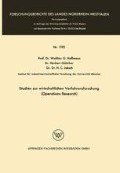Zusammenfassung
Die vorliegende Untersuchung beschäftigt sich mit linearen Programmen unter zeitlichen Bedingungen.
Access this chapter
Tax calculation will be finalised at checkout
Purchases are for personal use only
Preview
Unable to display preview. Download preview PDF.
Literaturverzeichnis
Antosiewicz, H. A., (ed.), Proceedings of the Second Symposium in Linear Programming, Washington 1955. Darin: M. E. SALVESON, The Assembly Line Balancing Problem, Vol. I. S. 55–101.
Baker, C. T., und B. P. Dzielinski, Simulation of a simplified Job shop, »Management Science« 6 (1960), S. 311–323.
Bellman, R., Dynamic Programming, Princeton 1957.
Ciiarnes, A., W. W. Cooper und A. Henderson, An Introduction to Linear Programming, New York 1953.
Ciienery, H. B., Process and Production Function from Engineering Data. In: W. LEONTIEF (ed.), Studies in the Structure of the American Economy, New York 1953. S. 297–325.
Churchman, C. W., R. L. Ackoff und E. L. Arnoff, Introduction to Operations Research, New York-London 1957.
Dantzig, G. B., A Comment on Eddie’s »Traffic Delay at Toll Booths«. Journ. of the Operations Res. Soc. of America 2 (1954), S. 339–341.
Ders., Upper Bounds, Secondary Constraints and Block Triangularity in Linear Programming, »Econometrica« 23 (1955), S. 174–183.
Ders., On the Status of Multistage Linear Programming Problems, »Management Science« 6 (1959), S. 53–72.
Dantzig, G. B., und D. R. Fulkerson, Minimizing the Number of Tankers to Meet a Fixed Schedule, »Naval Res. Logistics Quarterly« 1 (1954), S. 217–222.
Dorfman, R., Application of Linear Programming to the Theory of the Firm, Berkeley 1951.
Dorfman, R., P. A. Samuelson und R. M. SoLow, Linear Programming and Economic Analysis, New York-Toronto-London 1958.
Ferguson, A. R., und G. B. DANrzIG, The Allocation of Aircraft to Route — An Example of Linear Programming under uncertain Demand, »Management Science« 3 (1957), S. 45–73.
GASS, S. I., Linear Programming, New York-Toronto-London 1958.
GASS, S. I., und TII. L. Saary, Parametric Objective Function (Part 2) Generalization, » Jorn. of the Operations Res. Soc. of America« 3 (1955), S. 395–401.
Gomory, R., Outlines of an Algorithm for Integer Solutions to Linear Programs, »Bull. of the American Math. Soc.« 64 (1958), S. 275–278.
Gutenberg, E., Grundlagen der Betriebswirtschaftslehre, 1. Bd. Berlin-GöttingenHeidelberg 1951.
Henderson, J. M., und R. E. Quandr, Microecono nic Theory, New York-LondonToronto 1958.
Koopmans, T. C., (ed.), Activity Analysis of Production and Allocation, New York-London 1951. Darin: G. B. DANTZIG, The Programming of Interdependent Activities, Mathematical Model. S. 19–32. — M. K. WooD und M. A. GEISLER, Development of Dynamic Models for Program Planning, S. 198–215.
Krelle, W., Ganzzahliges Programmieren, Theorie und Anwendungen in der Praxis, »Unternehmensforschung« 2 (1958), S. 161–175.
Markowrrz, H. M., und A. S. Manne, On the Solution of Discrete Programming Problems, »Econometrica« 25 (1957), S. 84–101.
Moore, F. G., Production Control, New York-Toronto-London 1951.
Saaty, T., und S. Gass, Parametric Objective Function (Part 1), » Journ. of the Operations Res. Soc. of America« 2 (1954), S. 311–316.
Salveson, M. E., A problem in Optimal Machine Loading, »Management Science« 2 (1956), S. 232–260.
Schneider, E., Einführung in die Wirtschaftstheorie. II. Teil, 3. Aufl. Tübingen 1955. VAZSONY, A., Scientific Programming in Business and Industry New, York-London 1958.
Wagner, H. M., An Integer Linear-Programming-Model for Machine Scheduling, »Naval Research Logistics Quarterly« 6 (1959), S. 131–140.
Bowman, E. H., Assembly Line Balancing by Linear Programming, »Operations Research« 8 (1960), S. 385–389.
Nach Abschluß der Untersuchungen wurde ein neues Rechenverfahren zur Lösung ganzzahliger linearer Programmierungsprobleme veröffentlicht: A. H. LAND und A. G. DOIG, An Automatic Method of Solving Discrete Programming Problems, »Econometrica« 28 (1960), S. 497–520.
Rights and permissions
Copyright information
© 1964 Springer Fachmedien Wiesbaden
About this chapter
Cite this chapter
Joksch, H.C. (1964). Lineare Programme mit zeitlichen Bedingungen. In: Studien zur wirtschaftlichen Verfahrensforschung (Operations Research). VS Verlag für Sozialwissenschaften, Wiesbaden. https://doi.org/10.1007/978-3-663-04358-4_2
Download citation
DOI: https://doi.org/10.1007/978-3-663-04358-4_2
Publisher Name: VS Verlag für Sozialwissenschaften, Wiesbaden
Print ISBN: 978-3-663-03169-7
Online ISBN: 978-3-663-04358-4
eBook Packages: Springer Book Archive

